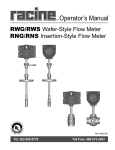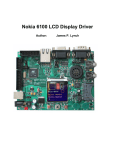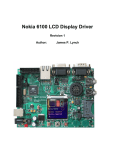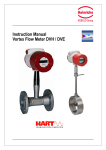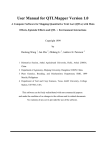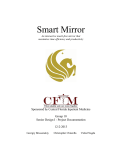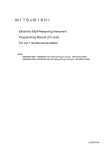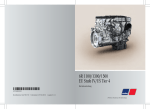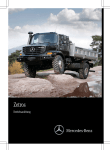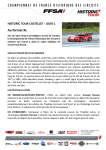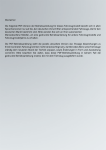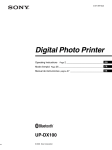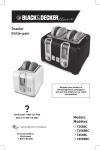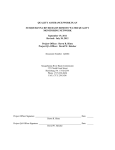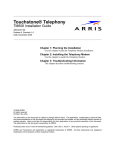Download Operator`s Manual
Transcript
Operator’s Manual Intrinsically Safe RWG/RWBG/RWS Wafer-Style Flow Meter RNG/RNS Insertion-Style Flow Meter FLOW Flow Flow RV-1001-R7 Tel: 262-639-6770 Toll Free: 888-572-2463 TABLE OF CONTENTS HEADING PAGE INTRODUCTION ........................................................................................................................................5 SPECIFICATIONS ......................................................................................................................................5 INSTALLATION ..........................................................................................................................................6 Installation Location ..............................................................................................................................6 Mechanical Installation .........................................................................................................................6 Meter Installation ..................................................................................................................................7 Electrical Installation ...........................................................................................................................12 EMC Notification .................................................................................................................................12 Instructions Specific to Hazardous Area Installations .........................................................................13 Flow Meter Wiring ...............................................................................................................................14 OPERATION.............................................................................................................................................15 Power Terminals .................................................................................................................................15 Current Output ...................................................................................................................................15 HART Communication ......................................................................................................................15 TROUBLESHOOTING .............................................................................................................................19 Preliminary Checks .............................................................................................................................19 WARRANTY .............................................................................................................................................30 WASTE ELECTRICAL AND ELECTRONIC EQUIPMENT (WEEE) DIRECTIVE .....................................30 LIST OF FIGURES FIGURE A B1 B2 B3 B4 B5 C D E F G H J K L1 L2 L3 L M N TITLE PAGE Internal Alignment RWG, RWBG and RWS Wafer Flow Meters ................................................7 Outline Dimensions for ½″, 1″, and 1½″ RWG, RWBG and RWS Wafer Flow Meters ..............8 Outline Dimensions for 2″, 3″, and 4″ RWG, RWBG and RWS Wafer Flow Meters ..................8 Outline Dimensions for RWG / RWS Flanged Flow Meters .......................................................9 Outline Dimensions for RNS Insertion Flow Meters .................................................................10 Outline Dimensions for RNG Insertion Flow Meters ................................................................. 11 Flow Meter Terminal Functions.................................................................................................14 Load Resistance Table .............................................................................................................15 Sensor Wiring Diagram (Without Pressure Transducer) ..........................................................16 Sensor Wiring Diagram (With Pressure Transducer) ...............................................................17 HART Communicator Menu Tree ...........................................................................................18 Typical Velocity Profile Hot Tap Configuration for RNS Insertion Flow Meter ..........................20 Hot Tap Configuration for RNS Insertion Flow Meter ...............................................................23 Hot Tap Configuration for RNG Insertion Flow Meter ...............................................................23 Turbulence Caused by Bend or Obstruction ............................................................................24 Swirl Caused by Two Bends in Different Planes and in Close Proximity to One Another ........24 Upstream/Downstream Sonic Noise Caused by Slightly Opened Control Valves ....................24 RNS Insertion Flow Meter Installed in a Reduced Pipe ...........................................................25 RNG Insertion Flow Meter Installed in a Reduced Pipe ...........................................................26 Intrinsically Safe Installation Drawing .......................................................................................27 Form No. RV-1001-R7 11/10 Page 3 LIST OF TABLES TABLE 1 2 3 4 5 6 7 TITLE PAGE Specifications .............................................................................................................................5 Flow Range Chart for RWG, RWBG Series Meters ...................................................................6 Flow Range Chart for RWS Series Meters .................................................................................6 Flow Range Chart for RNG Series Meters .................................................................................6 Flow Range Chart for RNS Series Meters .................................................................................6 Flow Profile (Raw Data) ...........................................................................................................25 Flow Profile (Normalized Data) ................................................................................................25 LIST OF APPENDIXES APPENDIX A TITLE PAGE ADDITIONAL INSTALLATION REQUIREMENTS ....................................................................20 Introduction ......................................................................................................................................20 Turbulence .......................................................................................................................................20 Swirl .................................................................................................................................................20 Sonic Noise .....................................................................................................................................20 Velocity Profile .................................................................................................................................20 Straight-Run Piping Considerations ................................................................................................21 Temperature and Pressure Tap Locations .......................................................................................21 Wafer-Style Sensor Installation .......................................................................................................21 Insertion-Style Sensor Installation ...................................................................................................21 Hot Tap Insertion Flow Meter Installation.........................................................................................22 Flow Profiling ...................................................................................................................................22 Reducing the Pipe Diameter ............................................................................................................22 B CERTIFICATION DOCUMENTS ..............................................................................................28 CE-ATEX Declaration of Conformity ................................................................................................28 Page 4 Form No. RV-1001-R7 11/10 INTRODUCTION The RNx/RWx/RWBG series vortex shedding flow meter family is designed to provide accurate and repeatable gas or steam flow measurement. These meters employ a patented ultrasonic technique to measure a form of turbulence created in the flow stream. This turbulence, known as the Von Karman Vortex Street, is related to the flow through the pipe. The RNx/RWx/RWBG series flow meter is a digital signal processing device, with HART® compatible communications. The primary output of the meter is a 2 wire, 4-20 milliampere (mA) current which is proportional to the flow. With HART Communications, users have the capability to remotely configure the meter. Typical operations, like re-scaling the analog output, can be performed in comfort using a standard PC or HART® 275/375 Communicator. The wafer-style meters are for pipe diameters four inches or less, and are installed between 150 lb. flanges, or are manufactured with pipe extensions and 150 lb. (300 lb. optional) flanges welded on the ends. These meters are calibrated in volumetric flow units, e.g. Actual Cubic Feet per Minute (ACFM). Flow rates for the wafer-style meters are listed in Tables 2 and 3. The insertion-style meters are retractable meters that are installed through the wall of a pipe or duct larger than four inches. These meters can be installed through a 2″ full port valve, which permits the unit to be retracted or inserted manually without shutting down the system. DANGER: Caution should be used when inserting or retracting at pressures exceeding 60 PSIG (4.14 BARg). ® Flow rates for the insertion-style meters are shown in Tables 4 and 5. TABLE 1 - SPECIFICATIONS Wafer Parameter Insertion Gas / Air Steam Gas / Air Operating Pressure -5 to +250 PSIG (-0.34 to +17 BARg) -5 to +150 PSIG (-0.34 to +10.3 BARg) -5 to +250 PSIG (-0.34 to +17 BARg) Operating Temperature -20 °F to +300 °F (-28 °C to +150 °C) -20 °F to +366 °F (-28 °C to +186 °C) -20 °F to +300 °F (-28 °C to +150 °C) Accuracy ±1% of Reading over the dynamic range of the flow meter Repeatability 0.5% of Reading Input Power +15 to +24 VDC* Output 4-20 mA (2 Wire Loop Powered) Mounting Requirements Mounts between two 150 lb flanges Options for 2” NPT, 2” 150# Flange, 2” 300# Flange, DN50 Flange Ambient Temperature -40 °F to +155 °F (-40 °C to +68 °C) Load Limits See Load Resistance Table (Table D) *The meter requires a minimum of 21 VDC for HART® Communications with a 250 Ω resistor and no load Form No. RV-1001-R7 11/10 Page 5 TABLE 2: FLOW RANGE - RWG/RWBG SERIES TABLE 3: FLOW RANGE - RWS SERIES Gas / Air Application Steam Application Model RWG05 RWG10 RWG15 RWG20 RWG30 RWG40 Pipe Size inch (mm) Flow ACFM (m³/hr) Minimum Maximum Model Pipe Size inch (mm) Flow ACFM (m³/hr) Minimum Maximum 0.5 1 1.5 2 3 4 0.4 (0.7) 16 (27) 1.2 (2.0) 45 (77) 2.0 (3.4) 100 (170) 5.0 (8.5) 200 (340) 10.0 (17.0) 400 (680) 20.0 (34.0) 600 (1019) RWS05 RWS10 RWS15 RWS20 RWS30 RWS40 0.5 1 1.5 2 3 4 0.40 (0.7) 1.25 (2.1) 3 (5.1) 5 (8.5) 13 (22.1) 23 (39.0) (13) (25) (38) (50) (76) (102) (13) (25) (38) (50) (76) (102) 10 (17) 35 (59) 100 (170) 160 (272) 320 (544) 480 (816) TABLE 4: VELOCITY RANGE - RNG SERIES TABLE 5: VELOCITY RANGE - RNS SERIES Gas / Air Application Steam Application (see Notes) Model Pipe Size inch (mm) RNG 4″ (13 mm) 6″ (152 mm) 8″ (203 mm) 10″ (254 mm) Velocity Range Minimum Maximum 2 (0.6) 140 (43) Model Pipe Size inch (mm) RNS 6″ (152 mm) 8″ (203 mm) 10″ (254 mm) 12″ (305 mm) Velocity Range Minimum Maximum 5 (1) 125 (38) Flow measured in feet / second @ 14.69 PSIA, 60 °F (meter / second @ 1.013 BAR, 16 °C) Notes for Table 5: When pressure is 0 to 25 PSIG, the range is 5 to 125 FPS (1 to 38 MPS). When pressure is 25 to 60 PSIG, the range is 5 to 158 FPS (1 to 48 MPS). When pressure is greater than 60 PSIG, the range is 5 to 175 FPS (1 to 53 MPS). INSTALLATION The flow meter is shipped completely assembled, tested and ready to install in its permanent location. See Figures B1 thru B5 for the applicable outline dimensions for specific meters. Installation Location The RNx/RWx/RWBG series meters uses ultrasonics to measure flow. An ultrasonic noise can interfere with this technique, therefore high intensity, ultrasonic noise sources should not be located upstream or downstream from the meter. Common mechanical ultrasonic noise sources include the following: Page 6 ● Slightly cracked valves operating with large pressure drops. ● Small pipe leaks in high pressure systems. ● Venturies operating at near-sonic flow rates. ● Sonic nozzles. If these ultrasonic noise sources cannot be eliminated, the meter should be mounted with at least one elbow between the flow meter and the noise source. Mechanical Installation The meter should be installed with at least 20 pipe diameters of straight pipe upstream and 10 pipe diameters downstream. This condition provides the fully developed, symmetrical flow profile that is necessary to obtain accurate and repeatable results. Shorter upstream/downForm No. RV-1001-R7 11/10 stream piping may be used although a shift in calibration may occur. If severe turbulence or distorted flow profiles are present, flow straighteners should be used. See Appendix A for additional installation information. Meter Installation The labeling of the flow direction on the meter should be aligned with the flow in the pipe. If liquids or condensate can be present in the flow, the meter should be installed so that liquids will not accumulate on the ultrasonic transducers (the small buttons on either side of the vortex strut). The RNS/RNG series insertion meters are designed to mount on a standard ANSI 150 lb., 2″ pipe flange. The measuring window should be installed in the center of the line for line sizes 12 inches or less (see Figures B4 and B5). For line sizes larger than 12 inches, the measuring window should be installed 25% to 50% of the way into the pipe. It is recommended that the internal dimensions of the line be measured for accurate readings. The RWG/RWBG/RWS series wafer meters are designed to mount between two ANSI 150 lb. flanges. The meter should be mounted so its inside diameter is centered inside the pipe (see Figure A). Insertion meters can be used in any size pipe four inches and larger in diameter. In order to calculate accurate volumetric, mass, and standard flow measurements, it is recommended to enter the exact pipe size into the meter. Normally this operation, along with overall meter configuration, is performed at the factory. However, the user can enter the pipe diameter on site using the Racine HART Interface or a HART® 275/375 communicator. Note: Gaskets (not provided) are necessary between the sensor and the ANSI flanges. Ensure that these gaskets are properly installed and do not protrude into the flow stream. Note: The torque requirement for the fitting is 50-60 ft. lbs. (see Figures B4 & B5). See Appendix A for additional installation information and flow profiling. CAUTION: Avoid bending the vortex strut or damaging the transducers during installation. Do not remove cover plates while unit is operating. The RWGxxF/RWSxxF series flanged meters are designed to mount between two ANSI 150 lb. flanges (300 lb. optional) (see Figure B3). Note: Gaskets (not provided) are necessary between the ANSI flanges. Ensure that these gaskets are properly installed and do not protrude into the flow stream. CORRECT (Meter Centered In Pipe) Flow INCORRECT (Meter Not Centered In Pipe) Flow FIGURE A - INTERNAL ALIGNMENT OF WAFER STYLE FLOW METERS Form No. RV-1001-R7 11/10 Page 7 5.75 4.50 3/4-14 NPT Pipe Plug 4.38" Cable Entry Accommodates .19/.25 Dia Cable 3/4 -14 NPT Connector .531 Dia 4 Holes Spaced at 90° on D Dia BC C +.12 -.00 Flow Flow E Dia Both Sides B Dia .06 Diameter A Diameter B 3.50 (89) 2.25 .06 A Dia GAS/AIR STEAM Dimension D Dimension E 2.38 (61) 1.38 (35) Model Dimension C Model Dimension C 0.50 (13) RWG/RWBG05 5.60 (142) RWS05 9.47 (241) 3.97 (101) 0.88 (22) RWG/RWBG10 5.78 (147) RWS10 9.65 (245) 3.12 (79) 2.00 (51) 4.72 (120) 1.38 (35) RWG/RWBG15 6.34 (161) RWS15 10.21 (259) 3.88 (99) 2.88 (73) All dimensions are in inches (mm) FIGURE B1 - ½″, 1″, AND 1½″ METERS 5.75 4.50 3/4-14 NPT Pipe Plug 4.38" Cable Entry Accommodates .19/.25 Dia Cable 3/4 -14 NPT Connector D Dia Both Sides +.12 C -.00 Flow Flow B Dia .06 2.25 .06 A Dia GAS/AIR Diameter A Diameter B 3.97 (101) 5.22 (133) 6.87 (174) STEAM Dimension C Diameter D Model Dimension C Model 1.75 (45) RWG/RWBG20 5.92 (150) RWS20 9.79 (249) 3.15 (80) 2.75 (70) RWG/RWBG30 6.62 (168) RWS30 10.49 (267) 4.55 (116) 3.75 (95) RWG/RWBG40 7.52 (191) RWS40 11.39 (289) 6.19 (157) All dimensions are in inches (mm) FIGURE B2 - 2″, 3″, AND 4″ METERS Page 8 Form No. RV-1001-R7 11/10 4.50 5.75 3/4-14 NPT Pipe Plug 4.69" A by HEDLAND SENSOR S.N.: 64 PRESSURE SENSOR: OUTPUT: 4 - 20 mA FLOW FLOW B DIM A SIZE DIM B ½″ 1″ 1½″ 2″ 3″ 4″ 9.88 - 10.00 (250 - 254) 9.88 -10.00 (250 - 254) 9.88 -10.00 (250 - 254) 9.88 -10.00 (250 - 254) 11.88 - 12.00 (301- 304) 11.88 - 12.00 (301- 304) GAS/AIR RWG05F15* RWG10F15* RWG15F15* RWG20F15* RWG30F15* RWG40F15* 5.60 (142) 5.78 (147) 6.34 (161) 5.92 (150) 6.62 (168) 7.52 (191) STEAM RWS05F15* RWS10F15* RWS15F15* RWS20F15* RWS30F15* RWS40F15* 9.47 (241) 9.65 (245) 10.21 (259) 9.79 (249) 10.49 (267) 11.39 (289) All dimensions are in inches (mm) FIGURE B3 - OUTLINE DIMENSIONS FOR FLANGED SERIES METERS *150 lb. RF ANSI Flange - 300 lb. RF ANSI Flange optional Form No. RV-1001-R7 11/10 Page 9 4.50 5.75 3/4-14 NPT Pipe Plug 4.38" C Maximum Retracted Cable Entry Accommodates .19/.25 Dia Cable 3/4 -14 NPT Connector 13.0" Maximum at Maximum Insertion FLOW Fitting Torque Requirements 50-60 ft.-lbs. .75" 6.10" Maximum Retracted A B Maximum Insertion 6.10" Maximum Measuring Window 1.63" Model Dimension A Dimension B Dimension C RNS12 RNS24 RNS36 RNS48 RNS60 12.00 (305) 24.00 (609) 36.00 (914) 48.00 (1218) 60.00 (1524) 15.0 (381) 27.0 (685) 39.0 (990) 51.0 (1295) 63.0 (1600) 21.5 (546) 33.5 (850) 45.5 (1155) 57.5 (1459) 69.5 (1765) All dimensions are in inches (mm) FIGURE B4 - OUTLINE DIMENSIONS FOR RNS INSERTION STEAM METERS Page 10 Form No. RV-1001-R7 11/10 4.50 5.75 3/4-14 NPT Pipe Plug 4.38" C Maximum Retracted 13.0" Maximum at Maximum Insertion FLOW .75" 4.50" Maximum Retracted B Maximum Insertion A 4.50" Maximum Measuring Window FLOW Model Dimension A Dimension B Dimension C RNG12 RNG24 RNG36 RNG48 RNG60 12.00 (305) 24.00 (609) 36.00 (914) 48.00 (1218) 60.00 (1524) 12.88 (327) 24.88 (632) 36.88 (937) 48.88 (1242) 60.88 (1546) 21.50 (546) 33.50 (851) 45.50 (1156) 57.50 (1461) 69.50 (1765) All dimensions are in inches (mm) FIGURE B5 - OUTLINE DIMENSIONS FOR RNG INSERTION AIR/GAS METERS Form No. RV-1001-R7 11/10 Page 11 ELECTRICAL INSTALLATION EMC NOTIFICATION Electrical connections for the meter are made using screw terminals located inside the enclosure. To access these terminals, remove the lid from the enclosure. The functions of these terminals are illustrated in Figure C. The ultrasonic sensing technology employs a 160 KHz carrier frequency and the flow meter is sensitive to radiated and conducted noise at or near this frequency. Precautions must be taken not to subject the flow meter or associated cabling to sources of RF noise that could interfere with the ultrasonic carrier. Any such interference can cause degradation in flow meter performance. To install the cable, route it through the cable entry located on either side of the enclosure and attach the wires to the appropriate terminals. It is recommended that a wire be attached from the external flow meter ground terminal to chassis ground, if the pipe is not connected to chassis ground. Page 12 Form No. RV-1001-R7 11/10 INSTRUCTIONS SPECIFIC TO HAZARDOUS AREA INSTALLATIONS (REFERENCE EUROPEAN ATEX DIRECTIVE 94/9/EC, ANNEX II, 1.0.6) THE FOLLOWING INSTRUCTIONS APPLY TO EQUIPMENT COVERED BY CERTIFICATE NUMBER SIRA 03ATEX2543 1. THE CERTIFICATION MARKING IS AS FOLLOWS: 2. THE EQUIPMENT MAY BE USED IN ZONES 1 AND 2 ONLY WITH FLAMMABLE GASES AND VAPORS WITH APPARATUS GROUPS IIA AND IIB AND WITH TEMPERATURE CLASSES T1, T2, T3 AND T4. IT IS NOT SUITABLE FOR ZONES WHERE IIC GASES OR VAPORS MAY BE PRESENT. 3. THE EQUIPMENT IS ONLY CERTIFIED FOR USE IN AMBIENT TEMPERATURES IN THE RANGE -40 °F (-40 °C) TO +176 °F (+80 °C) AND SHOULD NOT BE USED OUTSIDE THIS RANGE. 4. THE EQUIPMENT HAS NOT BEEN ASSESSED AS A SAFETY RELATED DEVICE (AS REFERRED TO BY DIRECTIVE 94/9/ EC ANNEX II, CLAUSE 1.5). 5. INSTALLATION, INSPECTION AND MAINTENANCE OF THIS EQUIPMENT SHALL BE CARRIED OUT BY SUITABLY TRAINED PERSONNEL IN ACCORDANCE WITH THE MANUFACTURER’S INSTRUCTIONS AND THE APPLICABLE CODES OF PRACTICE (e.g. EN 60079-14 AND EN 60079-17 IN EUROPE). 6. ONLY SPARE PARTS SUPPLIED BY RACINE VORTEX MAY BE USED AND INSTALLED IN ACCORDANCE WITH RACINE VORTEX’S INSTRUCTIONS. Form No. RV-1001-R7 11/10 Page 13 + 4-20MA NC EP RTN EP PWR EP OUT EP IN Cable Shield Ground Chassis Ground TERMINAL DESIGNATOR FUNCTION 4-20mA + LOOP POWER (+15 to 24 VDC) 4-20mA LOOP POWER (-) NC not used EP RTN PRESSURE SENSOR POWER SUPPLY RETURN EP PWR PRESSURE SENSOR POWER EP OUT POWER OUT TO PRESSURE SENSOR EP IN PRESSURE SENSOR INPUT FIGURE C - FLOW METER TERMINAL FUNCTIONS WIRING A two conductor foil shielded cable made of 14 to 22 AWG solid or stranded wire is required to make connections to the flow meter (e.g. Consolidated Wire P/N 5573-CL). Page 14 The shield is required to be attached to one of the shield ground points as illustrated in Figure C. The other end of the shield should not be grounded. Form No. RV-1001-R7 11/10 When using the Zener Diode Barrier the maximum load resistance for the power depends on the supply voltage (see Figure D). If a Barrier/Isolator is being installed, refer to the Barrier/Isolator manufacturer’s data sheet for maximum resistive loading on the output. (Excitation voltage input to meter must be 15 VDC minimum when output is at 20 mA). Various wiring configurations are shown in Figures E & F. OPERATION Power Terminals The 4-20 mA terminals (+ and -) are used for the flow meter’s power supply. Current Output The current output is accessed through the 4-20 mA + and - terminal loop and provides an output current proportional to the flow measured by the meter. This output is a standard 4-20 mA output, where 4 mA corresponds to no flow and 20 mA indicates 100 percent (full scale) flow. The current output will not be accurate if the load resistance on the current output terminal is too high. The maximum load resistance that the meter can drive versus the power supply voltage is shown in Figure D. Load Table for Flow Indicator or Control System Using Zener Diode Barrier Power Supply Voltage 24 V 26 V Maximum Voltage Drop 3V 5V Maximum Resistances 136 Ω 225 Ω For Loads Greater Than 225 Ω See Optional Wiring Diagram FIGURE D - LOAD TABLE Barriers and Barrier Isolator Examples Stahl 9001/01-280-100-10 Zener Barrier Turck MK33-221-Ex0-HL/24VDC (2 Channel) Turck MK33-111-Ex-HLi/24VDC (1 Channel) HART® Communication The Racine vortex meter has the capability of HART® Communication. However, it is not required that it be used. In most cases, the meter is configured at the factory per the customer’s specifications. The user need only install the meter and connect power. There are two ways to communicate to the meter via the HART® interface: the Racine HART Interface or a HART® Communicator. The Racine HART Interface is a PC based software program that runs on Windows 98, Windows NT, Windows ME, Windows XP, Windows Vista® and Windows® 7 operating systems. This program will provide access to all the settings that can be configured by the user. It also provides tools for diagnostics and trimming the analog output. The Racine HART Interface requires a HART® modem to convert the modulated HART® signal to the RS-232 communication standard. See the Racine HART Interface User’s Manual for more information about the Racine HART Interface. The HART® 275/375 Communicator is a handheld device that can communicate with any HART® device that is registered with the HART® Communication Foundation. The HART® 275/ 375 Communicator also provides access to all settings that can be configured by the user. The 275 provides a menu driven interface. See Figure G to view the menu map for the HART® 275 Communicator. Note: HART ® 275 Communicator requires Racine vortex drivers for proper communications. (See communicator owner’s manual for driver listing). Form No. RV-1001-R7 11/10 Page 15 WIRING DIAGRAMS The wiring diagrams illustrated below are for installations where no 4-20 mA pressure sensor is used. 28V BARRIER 4-20mA+ 4-20mANC EP RTN EP PWR EP OUT EP IN POWER SUPPLY 24 - 28 VDC FLOW INDICATOR - OR CONTROL SYSTEM SEE LOAD TABLE HART Fieldbus COMMUNICATIONS PROTOCOL oundation Page Up BK sp Delete Page Dn #%& ABC Copy Paset 1 2 GHI 4 7 ,( DEF 3 MNO +Hot Key TUV WXYZ 8 , ) Hot Key JKL Insert 5 PQRS <> 0 6 9 WXYZ _ SEE LOAD TABLE FIELD COMMUNICATOR 28V BARRIER FLOW INDICATOR - OR CONTROL SYSTEM 4-20mA+ 4-20mANC EP RTN EP PWR EP OUT EP IN POWER SUPPLY 24 - 28 VDC HART Fieldbus COMMUNICATIONS PROTOCOL oundation Page Up BK sp Delete Page Dn #%& ABC Copy Paset 1 2 GHI 4 7 ,( DEF 3 MNO +Hot Key TUV WXYZ 8 , ) Hot Key JKL Insert 5 PQRS <> 0 6 9 WXYZ _ FIELD COMMUNICATOR OPTIONAL WIRING DIAGRAM FOR LOADS > 225 Ω BARRIER / ISOLATOR 4-20mA+ 4-20mANC EP RTN EP PWR EP OUT EP IN Flow Indicator or Control System + - HART Fieldbus Page Up BK sp Delete Page Dn #%& ABC 1 2 Copy Paset GHI 4 7 ) 3 MNO +Hot Key WXYZ <> 0 - Hot Key JKL TUV 8 , DEF Insert 5 PQRS ,( gn COMMUNICATIONS PROTOCOL oundation POWER SUPPLY 24 - 29 VDC + NC 6 9 WXYZ _ HART FIELD COMMUNICATOR Fieldbus COMMUNICATIONS PROTOCOL oundation Page Up BK sp Delete Page Dn #%& ABC Copy Paset 1 2 GHI 4 7 ,( ) 3 MNO +Hot Key TUV WXYZ 8 , DEF Hot Key JKL Insert 5 PQRS <> 0 6 9 WXYZ _ FIELD COMMUNICATOR FIGURE E - WITHOUT 4-20 mA OUTPUT PRESSURE TRANSDUCER Page 16 Form No. RV-1001-R7 11/10 If an analog pressure gauge is used, it must be wired as shown below to avoid inadvertent current paths. A single supply can be used to power the flow meter and the external pressure sensor. The 4-20 mA flow indication must be taken from the source side of the loop. HART Fieldbus COMMUNICATIONS PROTOCOL oundation Page Up BK sp Delete Page Dn #%& ABC 1 2 Copy Paset GHI 4 7 ) DEF 3 MNO +Hot Key TUV WXYZ 8 , Hot Key JKL Insert 5 PQRS ,( <> 0 6 9 WXYZ _ 28V BARRIER FIELD COMMUNICATOR SEE LOAD TABLE FLOW INDICATOR - OR CONTROL SYSTEM 4-20mA+ 4-20mANC EP RTN EP PWR EP OUT EP IN POWER SUPPLY 24 - 28 VDC 28V BARRIER V+ RTN 4-20 mA Pressure Transmitter OPTIONAL WIRING DIAGRAM FOR LOADS > 225 Ω HART Fieldbus HART Fieldbus COMMUNICATIONS PROTOCOL oundation BK sp COMMUNICATIONS PROTOCOL oundation Page Up Page Up Delete BK sp DEF #%& ABC Copy Paset Page Dn #%& ABC Copy Paset 1 GHI 4 PQRS 7 ,( , ) 2 Hot Key JKL MNO Insert +Hot Key TUV WXYZ 5 8 <> 0 GHI 6 4 PQRS 9 7 ,( WXYZ _ FIELD COMMUNICATOR 4-20mA+ 4-20mANC EP RTN EP PWR EP OUT EP IN Delete Page Dn 1 3 BARRIER / ISOLATOR , ) 2 DEF 3 Hot Key JKL MNO Insert +Hot Key TUV WXYZ 5 8 <> 0 6 9 WXYZ _ FIELD COMMUNICATOR Flow Indicator or Control System + - Optional Pressure Sensor Output - + Pressure Transducer gn POWER SUPPLY 24 - 29 VDC FIGURE F - WITH 4-20 mA OUTPUT PRESSURE TRANSDUCER Form No. RV-1001-R7 11/10 Page 17 DEVICE SETUP PV AO LRV URV Edit Mode On / Off 7 Enable / Disable Edit Mode 1 2 3 4 5 6 1 PROCESS VARIABLES 2 DIAGNOSTICS AND SERVICE 1 VIEW FIELD DEVICE VARIABLES 1 2 3 4 5 6 2 TOTALIZER CONTROL 1 Total 2 Start / Stop 3 Reset 1 TEST / STATUS 1 View Status 2 Self Test 2 LOOP TEST 3 REVISION NUMBERS 4 Flow Profiling (Method) 5 VOLTAGE LEVELS 6 PRODUCT INFORMATION 7 DEBUG INFORMATION 3 BASIC SETUP 4 DETAILED SETUP 1 2 3 4 1 Fixed Current 2 D/A Trim Universal Cmd Revision Specific Cmd Revision PV Unit Select PV Unit 1 2 3 4 AGC Voltage APP Voltage ADC Voltage UPP Voltage 1 2 3 4 PV Type SELECT PV TYPE PV Unit SELECT PV UNIT 3 RANGE VALUE 1 2 3 4 5 URV LRV Min Span USL LSL 4 STANDARD CONDITIONS 5 PV Damping 6 Pipe ID 1 Base Temperature 2 Base Pressure 1 TEMPERATURE SETUP 1 TEMPERATURE SOURCE 2 Temperature Unit 3 User Specified Temperatur Value 2 PRESSURE SETUP 1 2 3 4 5 6 3 CONFIGURE OUTPUTS 1 PULSE OUTPUT 2 HART OUTPUT 3 LOCAL DISPLAY 4 DEVICE INFO 1 2 3 4 5 6 Manufacturer Descriptor Message Date Device ID Write Protect 1 2 3 4 5 6 7 8 Process Density Process Viscosity Standard Density PROPERTY SOURCE User Specified Density Value User Specified Viscosity Value Property Table Name Property Table Version Number 1 Tag 2 PV TYPE & UNIT 5 FLUID PROPERTIES 6 Alarm Selection 7 Low Flow Cutoff 5 REVIEW Process Variable Analog Output Percent of Range Vortex Frequency Process Temperature Precess Pressure 8 PASSWORD PROTECTION 5 UDC Voltage 6 VCC Voltage 7 Loop Voltage Select from a dynamic list of units PRESSURE SOURCE Pressure Unit User Specified Pressure Value Pressure LRV Pressure URV Atmospheric Pressure 1 2 3 4 5 6 7 8 9 Model Number Part Number Meter Style Sensor Option Display Option Model Deviation Modification Date Strut Size Calibration Date 1 2 3 4 5 6 MASS FLOW VOLUME FLOW STANDARD FLOW PROCESS TEMPERATURE PROCESS PRESSURE Vortex Frequnecy 1 2 3 4 Integrated RTD External RTD User Specified Temperature Steam Table 1 2 3 4 Analog Input - Absolute Analog Input - Gauge User Specified Pressure Steam Table 1 PULSE MODE 2 User Specified Frequency 3 Frequency URV 1 2 3 4 Polling Address Number of Preambles Burst Mode Burst Command 1 2 3 4 5 6 Process Variable Analog Output Totalizer Process Temperature Process Pressure Alternating PV & Totalizer 1 2 3 4 1 2 3 4 5 6 7 8 9 10 11 12 13 MPPS Rynolds Strouhal WDRS MTE MPE FCE LXP FCF DCF CSP CFV CSC Scaled PV Fixed Frequency Vortex Frequency Off 1 Property Table 2 User Specified Properties 3 Steam Table 1 Protection On / Off 2 Enable / Disable Protection 3 Forgot Password? FIGURE G - HART ® COMMUNICATOR MENU TREE V4.0 Page 18 Form No. RV-1001-R7 11/10 TROUBLESHOOTING Racine Vortex flow meters are designed to ensure long term accuracy and reliability. The stainless steel body and self-cleaning strut are specifically designed to withstand the rigors of industrial environments. As a result, periodic adjustment or re-calibration is not normally required. Technical assistance is available directly from Racine Vortex, providing complete re-calibration and repair service for the flow meter at a reasonable cost. Preliminary Checks DANGER: Do NOT open enclosure in hazardous areas with power applied. 1) Is the flow meter cable installed correctly? 2) Is the proper power supplied to the proper terminals? 3) Is the flow meter wired for 2 wire 4-20 mA operation? 4) Is the shield tied to the shield ground terminal and only the shield ground terminal? Form No. RV-1001-R7 11/10 Page 19 APPENDIX A - ADDITIONAL INSTALLATION REQUIREMENTS Introduction Installing a flow meter is something which requires careful consideration. It cannot just be placed in a line somewhere and be expected to fulfill its purpose adequately. The geometry and condition of the pipe runs in the area of the installation must be considered to ensure the best and most accurate operation of the flowmeter. This appendix provides suggestions for optimum installations. Most flow meter manufacturers define installation conditions in terms of upstream and downstream straight pipe lengths from the point of installation. Unfortunately this is not the only requirement, and one needs to consider other peripheral conditions, such as proximity and style of bends, and other equipment installed in the line. By doing this, you avoid problems of turbulence, swirl, and sonic noise. Turbulence Turbulence is a disturbance of the flow caused by bends and obstructions in the flow stream (it is this phenomena which makes the vortex flow meter work). Fortunately turbulence dies out fairly quickly, so by positioning the flow meter well away from bends and obstructions this potential problem of measuring flow in turbulent conditions is overcome (see Figure L1). Swirl Unlike turbulence, swirl will not die away. Once created it will continue until dissipated on the next pipe bend in the system. Swirl occurs after two bends, in close proximity, which are at an angle to each other. When designing an installation, keep the flow meter out of any line which has two adjacent bends upstream (see Figure L2). Sonic Noise Sonic noise is created by valves (either flow control or pressure control valves) which are slightly open. Like swirl, sonic noise will only dissipate on a bend so it is important to install flow meters out of the line of sight of valves. Sonic noise is caused by liquid attaining sonic velocities through a slightly open valve that has a pressure difference across it. This noise travels both up and down stream from the valve so you have to ensure that the flow meter is installed well away from the valve, preferably around a bend (see Figure L3). Velocity Profile When using an RNG/RNS series insertion flow meter, it is necessary to consider the effects of the velocity profile across the pipe or duct to optimize accuracy. In large pipes, the flow moves slowly at the pipe walls but is at maximum velocity in the center of the pipe creating a continuously variable velocity across the pipe (see Figure H). This velocity variation is called the velocity profile of the pipe, and can be measured and plotted by using the insertion flow meter to measure velocities at various noted positions across the pipe. As the maximum velocity is in the center of the pipe, it follows that if the flow meter is positioned in the center, it will not measure average flow. The “rule of thumb” position is 25% of the way into the pipe, but the optimum position can only be obtained by measuring the profile and working out the correct position from that. 1⁄8 ¼ ½ Flow FIGURE H - TYPICAL VELOCITY PROFILE Page 20 Form No. RV-1001-R7 11/10 Straight-Run Piping Considerations The sensor should be installed with 20 diameters, or more, of straight, unobstructed, full area pipe upstream of the flow meter installation and 10 diameters, or more, downstream. This condition provides the fully developed, symmetrical flow profile that is necessary to obtain accurate and repeatable results. The first obstruction upstream and downstream should be a full area elbow. If the minimum straight run is not possible, the general rule is to have 80% of the straight run upstream and 20% downstream from the flow meter installation. High intensity ultrasonic noises should not be located upstream or downstream from the sensor. Common ultrasonic noise sources include the following: ● Slightly cracked valves operating with large pressure drops. ● Small pipe leaks in high pressure systems. ● Venturies operating at near-sonic flow rates. ● Sonic nozzles. If these ultrasonic noise sources cannot be eliminated, the meter should be mounted with at least one elbow between the flow meter and the noise source. Temperature and Pressure Tap Locations User supplied pressure and temperature sensors should be mounted downstream from the flow meter. The pressure sensor should be approximately 3-5 pipe diameters and the temperature sensor approximately 4-8 pipe diameters downstream. Form No. RV-1001-R7 11/10 Wafer-Style Sensor Installation The flow meter is shipped completely assembled, tested and ready to install and operate in its permanent location. The RWG/RWS waferstyle flow meters are designed to mount between two ANSI flanges. The flow meter should be mounted so its inside diameter is centered inside the pipe. The labeling of the flow direction of the flow meter should be aligned with the flow in the pipe. Note: Gaskets (not provided) are necessary between the sensor and ANSI flange. It is recommended that the customer conduct a flow profile survey prior to installing flow meter. Insertion-Style Meter Installation The flow meter is shipped completely assembled, tested and ready to install and operate in its permanent location. If the main line can be depressurized easily, then a simple installation, consisting of a 2″ (51 mm) nozzle and a standard ANSI 150 lb, 2″ pipe flange may be used. This permits the shortest shaft length to be used, which keeps clearance space requirements for insertion and removal to a minimum. Note: Gaskets (not provided) are necessary between the sensor and ANSI flange. It is recommended that the customer conduct a flow profile survey prior to installing flow meter. DANGER - Caution should be used when inserting or retracting at pressures exceeding 60 PSIG (4.14 BARg). Page 21 Hot Tap Insertion Flow Meter Installation Where de-pressurizing the line for flow meter maintenance is impossible or undesirable, the “hot tap” method of installation is used. This method involves inserting the flow meter through a 2″ (51 mm) spool piece and a 2″ (51 mm) full port valve and will require a longer shaft length as well as greater clearance space for removal and installation. DANGER - Caution should be used when inserting or retracting at pressures exceeding 60 PSIG (4.14 BARg). Figures J & K show a sample hot tap installation. With the exception of the spool piece, which must be a minimum of 6″ (152.4 mm) Figure J in length, or a minimum of 4.5″ (114.3 mm) Figure K, all of the dimensions are suggestions only. Actual dimensions may vary depending on customer’s own hot tap configuration. To calculate the required insertion flow meters stem length: For pipe diameters less than or equal to 24″ (609 mm): Calculate the distance from the center line of the pipe to the top of the flow meter mounting flange. For pipe diameters greater than 24″ (609 mm): Calculate the distance from the top of the flow meter flange to a point ¼ of the pipe diameter into the pipe. Flow Profiling If the flow meter is long enough to be inserted to the far side of the pipe, the flow through the pipe may be profiled at various flow rates. The goal is to find a point in the pipe that remains a consistent percentage of the average flow rate over a wide range of flow. A sample flow profile is shown in Table 6. In this example, the flow rate of a 48″ pipe is measured every six inches across the diameter of the pipe beginning and ending 3″ from the near and far sides of the pipe. The distance in inches from the nearside of the pipe is shown. Measurements are taken at a low, medium and high average flow. In Table 7 the flow rate at each measurement point has been converted to a percentage of the average flow. It can be seen that point number three (15″ from the near side of the pipe) reads a consistent 102 percent of the average flow. The meter should be placed in this position and the output should be divided by 1.02 to obtain the correct reading. Flow profiling will generally improve measurement quality in insertion meter installations. Reducing the Pipe Diameter To decrease the variation of flow profile, the piping can be narrowed at the flow meter as shown in Figure S. This will smooth the flow and increase the effectiveness of flow profiling. Nearly any angle can be used on the downstream side of the meter to restore the original pipe diameter. However, if the angle of piping is seven degrees or less, nearly all the pressure drop caused by the narrow pipe section will be recovered. When flow profiling is required, calculate the distance from the bottom of the pipe to the top of the flow meter mounting flange and subtract 2″ (51 mm). Next round this distance up to the next largest 12″ (305 mm) increment. This is the stem length that should be ordered. Page 22 Form No. RV-1001-R7 11/10 5.75 5.75 4.38" 4.38" Determined By Stem Length Determined By Stem Length 13.0" Maximum at Maximum Insertion Cable Entry Accommodates .19/.25 Dia Cable 3/4 -14 NPT Connector 13.05" Maximum at Maximum Insertion FLOW FLOW Standard ANSI 2 Inch 150 Lb. Flange Standard ANSI 2 Inch 150 Lb. Flange 6.10" Maximum Retracted Spool Piece 6.00" Minimum 6.10" Maximum 4.50" Maximum Retracted Spool Piece 4.50" Minimum 2" Full Port Valve Cable Entry Accommodates .19/.25 Dia Cable 3/4 -14 NPT Connector Determined By Stem Length Flow FIGURE J - HOT TAP CONFIGURATION RNS INSERTION STEAM METERS 2" Full Port Valve 4.50" Maximum Determined By Stem Length Flow FIGURE K- HOT TAP CONFIGURATION RNG INSERTION GAS METERS DANGER - Caution should be used when inserting or retracting at pressures exceeding 60 PSIG (4.14 BARg). Form No. RV-1001-R7 11/10 Page 23 Flow Flow FIGURE L1 - TURBULENCE CAUSED BY BEND OR OBSTRUCTION FIGURE L2 - SWIRL CAUSED BY TWO BENDS IN DIFFERENT PLANES AND IN CLOSE PROXIMITY TO ONE ANOTHER FIGURE L3 - UPSTREAM/DOWNSTREAM SONIC NOISE CAUSED BY SLIGHTLY OPENED CONTROL VALVES Page 24 Form No. RV-1001-R7 11/10 TABLE 6 - FLOW PROFILE (RAW DATA) FLOW RATE AT MEASUREMENT POINT (FPS) FLOW 1 2 3 4 5 6 7 8 AVERAGE (FPS) LOW FLOW 1.90 2.00 2.04 2.06 2.06 2.04 2.00 1.90 MEDIUM FLOW 5.58 5.91 6.12 6.21 6.24 6.18 6.06 5.70 HIGH FLOW 10.92 11.70 12.24 12.48 12.60 12.48 12.18 11.40 DISTANCE (in) 3 9 15 21 27 33 39 45 2.0 6.0 12.0 TABLE 7 - FLOW PROFILE (NORMALIZED DATA) FLOW RATE AT MEASUREMENT POINT (%) FLOW 1 LOW FLOW 95.0 MEDIUM FLOW 93.0 HIGH FLOW 91.0 2 3 4 5 6 7 8 100.0 102.0 103.0 103.0 102.0 100.0 95.0 98.5 102.0 103.5 104.0 103.0 101.0 95.0 97.5 102.0 104.0 105.0 104.0 101.5 95.0 FLOW D 30° Flow d 3d 1d 7° FIGURE L - RNS INSERTION STEAM METER INSTALLED IN A REDUCED PIPE Form No. RV-1001-R7 11/10 Page 25 FLOW D 30° Flow d 3d 1d 7° FIGURE M - RNG INSERTION GAS METER INSTALLED IN A REDUCED PIPE Page 26 Form No. RV-1001-R7 11/10 FIGURE N - INTRINSICALLY SAFE INSTALLATION DRAWING A B C D E F G H NOTES: UNLESS OTHERWISE SPECIFIED 3. RADII TO BE .005/.010 2. FINISH TO BE 63 1. REMOVE ALL BURRS AND BREAK SHARP EDGES .005/.010 − POWER SUPPLY +19 . . . 29V + UTILIZING ISOLATED REPEATING BARRIERS 11 4 2 4 3 3 STAHL 9001 / 01−280−100−10 STAHL 9001 / 01−280−100−10 1 2 1 4−20mA Loop 28 Vdc 100mA 87nF 0.0mH NON-HAZARDOUS LOCATION V Max I Max Ci Li 9 4−20 FLOW 4−20 PRESSURE 9 250 10 6 5− 12− 11+ 3 4+ gn 250 2− 1+ 9− 8+ 10− 7+ TURCK MK33 − 2210ExO − HLi / 24VDC * = NOTE: IF CONTROL ROOM EQUIPMENT CANNOT ACCEPT INPUT VOLTAGE UP TO POWER SUPPLY PONTENTIAL, UTILIZE ISOLATED REPEATING BARRIER OR DISCRETE LOOP ISOLATORS. RL CONTROL ROOM EQUIPMENT +Ue −Ue RL CONTROL ROOM EQUIPMENT +Ue −Ue UTILIZING ZENER BARRIERS POWER SUPPLY +24 . . . 28V 10 8 7 OPTIONAL 7 (CLASSIFIED) CLASS I, ZONE 1 GROUP II B T4 (A)Ex ib IIB T4 HAZARDOUS LOCATION External Pressure IN 28 Vdc 100mA 0.0uF 0.0mH 8 + − 6 + 6 − 4−20mA PRESSURE TRANSDUCER 4−20mA PRESSURE TRANSDUCER 5 5 3 LTR A ZONE ALL RELEASED 2 4 Voc Isc Ca La MATERIAL: UNLESS OTHERWISE SPECIFIED DIMENSIONS ARE IN INCHES TOLERANCE ON DECIMALS .00 ±.010, .000 ±.005 ANGLES ±1/2° T. PAUL 3 THIS DRAWING WAS DONE ON AUTOCAD AND CAN ONLY BE REVISED ON A AUTOCAD SYSTEM. ANY MANUAL CHANGES DONE TO THIS DRAWING WILL BE IGNORED UNLESS AUTHORIZED. DATE: SUPERSEDES: REVISED BY: ENGINEER: CHECKED BY: DRAWN BY: RNSnn - nnnSNTA RWSnn - nnnSNTA CHECKED BY: RNGnn - nnnnNnA RWBGnn - nnnSNnA RWGnn - nnnSNnA 8/4/10 2 SCALE: D SIZE: NAME: INSTALLATION DRAWING APPLICABLE TO MODELS: BARRIER Vmax Imax Ci + Cc Li + Lc ≥ ≥ ≤ ≤ I.S. EQUIPMENT TABLE 1 APPROVAL RACINE, WI. U.S.A. TEL: 262-639-6770 FAX: 262-639-2267 8/12/10 DATE 1 NONE 59380 CODE I.D. NO. CURRENT REV: A 1 SHEET: 1 OF 1 RF200000 PART NUMBER: INSTALLATION DRAWING INTRINSICALLY SAFE AREAS, RWG, RWBG, RNG, RWS, RNS SERIES 1. CONTROL EQUIPMENT MUST NOT USE OR GENERATE MORE THAN 250 V. WITH RESPECT TO EARTH. NOTES ON CONTROL EQUIPMENT: 1. ALL CABLE ENTRIES INTO THE ENCLOSURE MUST BE BROUGHT THROUGH SUITABLE SIZED UL & CSA CERTIFIED LIQUID TIGHT STRAIGHT THRU FITTINGS. NOTES ON CABLE ENTRY: – E.C.N. RF200000 REVISIONS DESCRIPTION 1. SELECTED BARRIERS MUST BE CSA CERTIFIED AS INTRINSICALLY SAFE FOR THE APPLICATION AND HAVE Voc NOT EXCEEDING Vmax AND Isc NOT EXCEEDING Imax CAPACITANCE VALUE SHALL BE AS SHOWN IN TABLE 1. 2. CABLE CAPACITANCE, PLUS INTRINSICALLY SAFE EQUIPMENT CAPACITANCE, MUST BE LESS THAN MARKED CAPACITANCE (co) SHOWN ON ANY BARRIER USED. THE SAME APPLIES FOR THE INDUCTANCE. 3. MAY BE IN DIVISION 2 LOCATION IF SO APPROVED. 4. BARRIERS MUST BE INSTALLED IN ACCORDANCE WITH BARRIER MANUFACTURER’S CONTROL DRAWING, CANADIAN ELECTRICAL CODE PART 1, SEC 18 AND APPENDIX F, AND ARTICLE 504 OF THE NEC AS APPLICABLE TO LOCAL CODES. 5. WHEN SELECTING CABLE FOR CONNECTION TO RACINE VORTEX FLOW METER, USE CABLE WITH THE FOLLOWING PARAMETERS; 0.2μh / ft. and 60ρF / ft. NOTES ON BARRIERS: 4 PART NUMBER: 11 + − 4−20mA + − 4−20mA THIS DRAWING IS PROPRIETARY TO RACINE FEDERATED INC. RECEIPT OR POSSESSION CONFERS NO RIGHT TO USE THE SUBJECT MATTER OF THIS DRAWING OR TECHNICAL INFORMATION SHOWN; NOR THE RIGHT TO REPRODUCE THIS DRAWING OR ANY PART EXCEPT FOR THOSE SUPPLIERS OF RACINE FEDERATED INC. WHO RECEIVE A WRITTEN REQUEST FOR MANUFACTURE OR SIMILAR USE. EP RTN EP PWR EP OUT EP IN EP RTN EP PWR EP OUT EP IN Form No. RV-1001-R7 11/10 Page 27 A B C D E F G H APPENDIX B - CERTIFICATION DOCUMENTS 8635 Washington Avenue, Racine, WI 53406-3738 Phone: (262)-639-6770 Fax: (262)-639-2267 Website: www.racinefed.com Declaration of Conformity Manufacturer's Name: Racine Federated Inc. Manufacturer's Address: 8635 Washington Avenue Racine, WI 53406 USA Declares that the Products: RWG05, RWG10, RWG15, RWG20, RWG30, RWG40, RWS05, RWS10, RWS15, RWS20, RWS30, RWS40, RNG, RNL (Formerly J-Tec Associates Models: JW7nnn, JW7nnnS, JI7000, JI8000) Conform to the following Standards: Safety: Emissions: Immunity: Directive 94/9/EC EN 55022 IEC 61000-4-2: 2001 IEC 61000-4-3: 2002 IEC 61000-4-4: 1995 IEC 61000-4-5: 2001 IEC 61000-4-6: 2001 The products listed above are in conformity with the requirements of the EMC Directive 89/336/EEC. Reference Documents: SIRA Assessment Report No. R52A18641A EMC Test Report No. 3042281.011, April 30, 2003, by Intertek Testing Services EMC Test Report, May 13, 2003, conducted at Intertek Testing Services Test Report, Order No. 200251303, February 19, 2003 by NEMKO Supplementary Information: Date: March 29, 2010 Signature: Its: Page 28 Form No. RV-1001-R7 11/10 NOTES Form No. RV-1001-R7 11/10 Page 29 Division of Racine Federated Inc. Limited Warranty and Disclaimer Racine, division of Racine Federated Inc. warrants to the end purchaser, for a period of one year from the date of shipment from the factory, that all flow meters, electronic accessories and other products manufactured by it are free from defects in materials and workmanship. This warranty does not cover products that have been damaged due to misapplication, abuse, lack of maintenance, or improper installation. Racine’s obligation under this warranty is limited to the repair or replacement of a defective product, at no charge to the end purchaser, if the product is inspected by Racine and found to be defective. Repair or replacement is at Racine’s discretion. A returned goods authorization number must be obtained from Racine before any product may be returned for warranty repair or replacement. The product must be thoroughly cleaned and any process chemicals removed before it will be accepted for return. The purchaser must determine the applicability of the product for its desired use and assumes all risks in connection therewith. Racine assumes no responsibility or liability for any omissions or errors in connection with the use of its products. Racine will under no circumstances be liable for any incidental, consequential, contingent or special damages or loss to any person or property arising out of the failure of any product, component or accessory. All expressed or implied warranties, including the implied warranty of merchantability and the implied warranty of fitness for a particular purpose or application are expressly disclaimed and shall not apply to any products sold or services rendered by Racine. The above warranty supersedes and is in lieu of all other warranties, either expressed or implied and all other obligations or liabilities. No agent or representative has any authority to alter the terms of this warranty in any way. Waste Electrical and Electronic Equipment (WEEE) Directive In the European Union, this label indicates that this product should not be disposed of with household waste. It should be deposited at an appropriate facility to enable recovery and recycling. For information on how to recycle this product responsibly in your country, please visit: www.racinefed.com/recycle/ Page 30 Form No. RV-1001-R7 11/10 Form No. RV-1001-R7 11/10 Page 31 Division of Racine Federated Inc. 8635 Washington Avenue • Racine, WI 53406-3738 USA Tel: 262-639-6770 or 888-572-2463 Fax: 262-639-2267 e-mail: [email protected] www.racinevortex.com Racine is a trademark of Racine Federated Inc. HART is a registered trademark of the HART Communication Foundation. WINDOWS and VISTA are registered trademarks of Microsoft Corporation. UL is a registered trademark of Underwriters Laboratories. © 2010 Racine Federated Inc. All rights reserved. Printed in USA Form No. RV-1001-R7 11/10
































